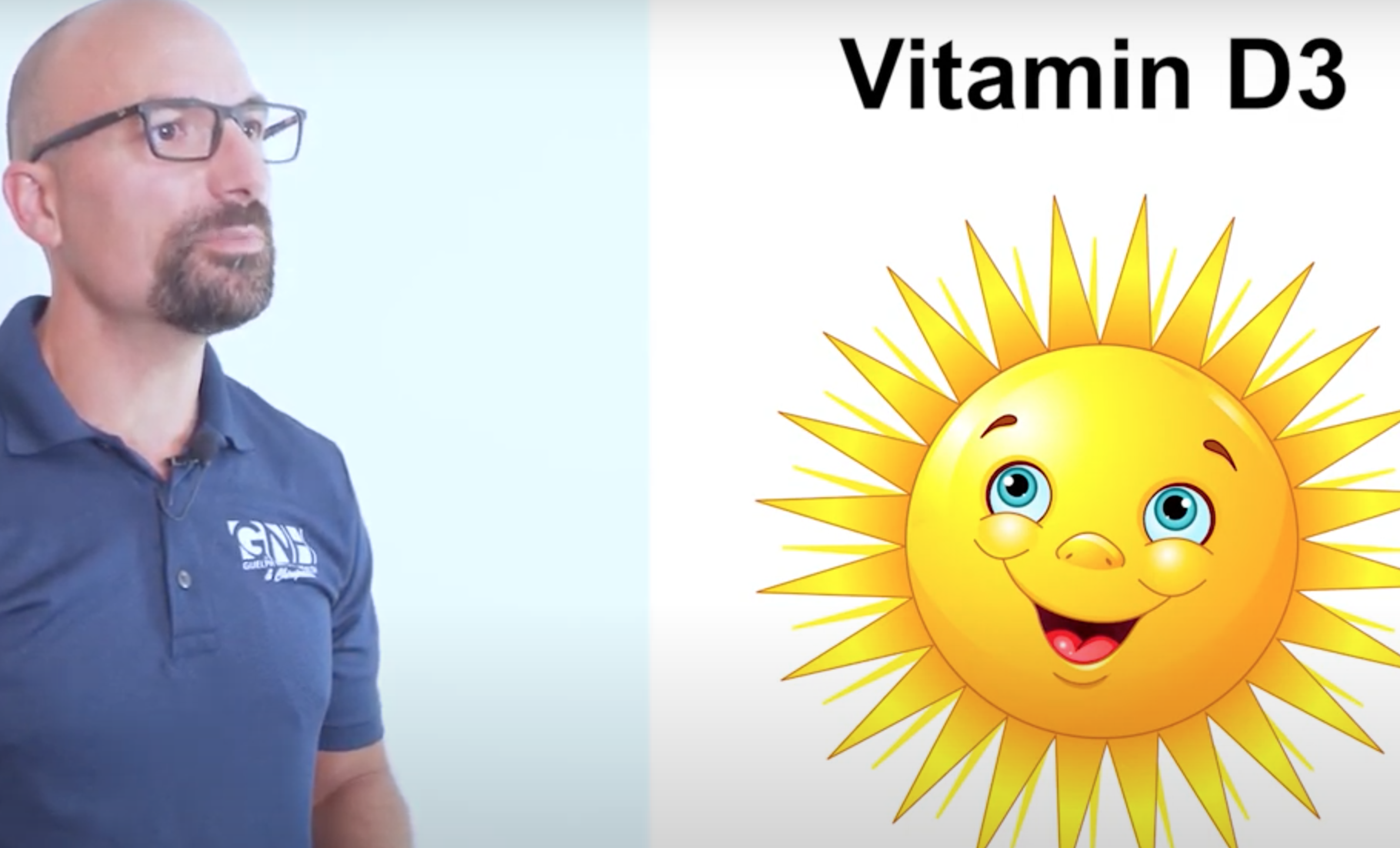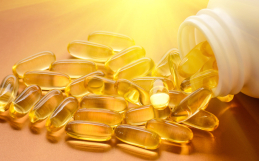Do you get sick often, feel depressed or anxious, have high blood pressure, or restless sleep?
These are all possible signs or symptoms of vitamin D deficiency. I will provide updates on the top benefits of the sunshine vitamin (D3) and video below.
Classically, vitamin D3 or the sunshine vitamin is known for its ability to increase calcium absorption from the gut and related to strong bones and teeth.
Vitamin D is a fat-soluble nutrient. The sun is the major natural source of the nutrient, but vitamin D is also found naturally in fish and eggs. It is also added to dairy products.
The #1 cause of vitamin D deficiency is lack of sun exposure. Deficiency is common in those of us that live north of the equator. Getting in the sun responsibly, without protection and not allowing skin to burn is a great addition to your lifestyle, which optimizes your health and longevity. There are many benefits of getting into nature other than Vitamin D I have reviewed here . The deficiency of vitamin D may be also caused by poor nutrition or issues of absorption in the gut.
Using technology to track Vitamin D.
This interesting app, dminder, can be used to track the vitamin D you receive from the sun based on your geographical location, season, time of day and percentage of skin exposed. You will quickly realize how little Vitamin D you will make based on these factors.
What is Vitamin K2?
Vitamin K2 (great infographic here) works together or synergistically with vitamin D3 to support heart health, bone health, immune function and more. Vitamin K2 is a nutrient that is now well-known to be crucial for the proper distribution of calcium into your bones and teeth and away from the heart, blood vessels, joints and other soft tissues.
Taking vitamin D as a supplement is associated with a wide range of benefits, including increased cognition, immune health and bone health. It can also reduce the risks of cancer, heart disease, diabetes and autoimmune diseases (see further research review here). Lifting weights, weight bearing activities, whole-body vibration (WBV) platforms or plates, and sprinting (post on top 3 workouts to get in the best shape of your life) also stimulate bone mineralization and decreases bone breakdown.
Take high quality vitamin D3 (not D2) — for most adults 2,000- 5,000 IU per day is enough. I recommend taking the supplement for a period of time and then having your vitamin D level tested. Too little of it is not good, but too much of it is also not good. So make sure you are testing, especially if you are taking higher doses.
Why the Sunshine Vitamin is crucial for optimal health
Some may recall the condition of rickets as deformed bowing of the legs with extreme vitamin D deficiency as the bones would not have enough calcium to sustain the weight of the body. Suntanning was then used to prevent rickets.
Vitamin D3 is one of the 24 micronutrients critical for human survival.
Robust evidence suggests that vitamin D is protective against respiratory tract infections. Data from 25 randomized controlled trials from around the world demonstrate that daily or weekly supplementation of vitamin D reduced the risk of acute respiratory infection by more than 50 percent in people with low baseline vitamin D levels. People with higher baseline vitamin D levels also benefited, although the effect was more modest, with only a 10 percent risk reduction.
There is mounting research that vitamin D may be an important supplement to reduce or prevent Covid-19. In this study, more than 80 per cent of hospitalized COVID-19 patients had vitamin D deficiency. “Research is starting to show the importance of Vitamin D in strengthening your immune system and possibly reducing your risk/severity/death of COVID-19,” says Vitamin D Society Executive Director Perry Holman.
Factors that affect the amount of ultraviolet radiation received and thus vitamin D synthesis include:
- season
- time of day
- cloud cover
- smog
- skin pigmentation
- sunscreen use
As is the case with many other nutrients (perhaps all nutrients), there is a U-shaped curve for vitamin D. People deficient in vitamin D may also experience increased testosterone levels after supplementation.
Other causes of Vitamin D Deficiency
Many know lack of sun exposure causes vitamin D deficiency, but don’t realize certain chemicals in plastics, such as BPA, can affect the formation of vitamin D and create a deficiency. That water bottle, receipt, or plastic coffee lid is full of BPA.
Try getting outside 20-30 minutes per day. Food is not a great source of vitamin D ,although the top options are wild-caught salmon and cod liver oil.
You want to take high quality vitamin D3 (not D2) — for most adults 2,000- 5,000 IU per day is enough. I recommend taking the supplement for a period of time and then testing your blood. When supplementing with vitamin D, remember it is fat soluble. Eat with a healthy fat, such as coconut oil, avocado, or almond butter to optimize absorption. My family takes fish oil, cod liver oil 2-3 times per week along with vitamin D or these drops for the kids.
There’s no doubt that vitamin D is crucial. It affects over 3,000 genes and plays a really important role in many different processes. Vitamin D deficiency is associated with numerous diseases, so we absolutely need to ensure that our body possesses it in adequate levels.
But, as is the case with many other nutrients (perhaps all nutrients), there is a U-shaped curve for vitamin D. Too little of it is not good, but too much of it is also not good. So make sure you are testing, especially if you are taking higher doses. Also, vitamin A and K2 protect you from vitamin D toxicity.
What is the Relationship with Vitamin K2?
If you understand the mechanism of Vitamin K2 (great infographic here), you’ll know that one of the main roles of K2 is to make sure that calcium gets into the bones and the teeth and the hard tissues where it belongs and stays out of the soft tissues where it doesn’t belong. And vitamin D, of course, regulates calcium metabolism, too.
Vitamin K is plentiful in green vegetables and can be converted into vitamin K2, but the conversion is pretty inefficient. By itself, vitamin K2 is only found in certain foods, like organ meats, natto (a fermented soy product common in Japan), and cheeses — particularly grass-fed cheese because, as I just mentioned, vitamin K is found in green vegetables, for instance, the grass that the cows eat.
Dr Chris Masterjohn’s Review of The Health Benefits of Vitamin K2
“Vitamin K2 has a wide range of underappreciated health benefits:
-
- It prevents calcium from going into all the wrong places and makes sure it gets into all the right places. For example, it keeps it out of your kidneys, where it would cause kidney stones, and keeps it out of your blood vessels, where it would cause heart disease, but helps it to get into your bones and teeth, making your bones strong and your teeth resistant to cavities.
- It helps you make insulin and remain very sensitive to insulin. This means it helps stabilize your blood sugar, protects against diabetes, and prevents the metabolic problems that often arise as a consequence of obesity.
- It promotes sexual health by helping you optimize your sex hormones. For example, it increases testosterone and fertility in males, and it helps bring the high levels of male hormones found in women with polycystic ovarian syndrome (PCOS) back down to normal.
- It helps improve exercise performance by enhancing your ability to utilize energy during bouts of physical activity.
- It protects against cancer by suppressing the genes that make cells cancerous and expressing the genes that make cells healthy.”
Optimal Vitamin D Levels
Vitamin D absorption is not the same for everyone. The only way to know is to test the blood. For example, optimal vitamin D exposure for those living in equatorial regions is higher than for people living at northern latitudes.
This is a fairly new finding, but it basically means that one person’s optimal vitamin D level is different than another person’s. Unfortunately, we’re not at the point where we can easily identify a person’s optimal vitamin D level. At some point in the future, people will be able to go in and just get a test to determine the optimal intake of vitamin D for them, based on genetics, skin color, latitude, and other relevant factors. This reality isn’t far away, but we’re not there yet.
According to Health Canada:
Many people meet at least some of their vitamin D needs through exposure to sunlight. However, season, time of day, cloud cover, smog, skin pigmentation, and sunscreen use are all factors that can affect the amount of ultraviolet radiation received and thus vitamin D synthesis.
- People are at risk of vitamin D deficiency (rickets or osteomalacia) at serum 25(OH)D concentrations <30 nmol/L. Some are potentially at risk for inadequacy at levels ranging from 30–50 nmol/L.
- Practically all people are sufficient at levels ≥50 nmol/L
- There may be reason for concern at serum concentrations >125 nmol/L , especially if not paired with calcium
Below first column is age, second column is the lower limit and third column is the upper limit:
| Infants 0-6 months | 400 IU (10 mcg) | 1000 IU (25 mcg) |
| Infants 7-12 months | 400 IU (10 mcg) | 1500 IU (38 mcg) |
| Children 1-3 years | 600 IU (15 mcg) | 2500 IU (63 mcg) |
| Children 4-8 years | 600 IU (15 mcg) | 3000 IU (75 mcg) |
| Children and Adults
9-70 years |
600 IU (15 mcg) | 4000 IU (100 mcg) |
| Adults > 70 years | 800 IU (20 mcg) | 4000 IU (100 mcg) |
| Pregnancy & Lactation | 600 IU (15 mcg) | 4000 IU (100 mcg) |
The Vitamin D society recommends 100-150 nmol/L (40-60 ng/ml) for adults. The Vitamin D Society is a Canadian non-profit group organized significantly improve the health of Canadians through the preventative health strategy of maintaining optimum vitamin D blood levels.
“Vitamin D deficiency is a sunlight deficiency. To reverse the downward trend of vitamin D levels for Canadians requires a change of public attitude and health policy towards sun exposure,” says Perry Holman, Executive Director for the Vitamin D Society. “We need to stop demonizing sun exposure and provide people with a complete balanced assessment of the risks and benefits involved.”
As long as you’re eating nutrient dense food, including grass-fed dairy, fermented vegetables, cod liver oil, and organ meats (primarily liver), then your vitamin A and vitamin K2 needs will be covered and the risk of vitamin D toxicity is low. Also consider supplementation of magnesium (review magnesium research here) and and eating foods with potassium.
I still recommend testing your vitamin D levels and getting an accurate number on a regular basis. Don’t hesitate to test before and after a set period of supplementation. I have been doing this for years with my nutrition, exercise, and lifestyle changes to see how they will affect my blood work, performance and energy levels.
According to Dr. Rhonda Patrick’s review of the epidemiology of vitamin D deficiency:
“When we look at the demographics, epidemiologists have long known where vitamin D deficiency tends to concentrate and what populations are the most affected:
- The elderly where the efficiency of cutaneous biosynthesis of vitamin D declines with age. According to NHANES data, older adults were 63 % more likely to have vitamin D deficiency and 46 % more likely to have vitamin D insufficiency than young adults while other sources have suggested a 70-year-old may produce 4 times less vitamin D than their former 20-year-old selves.
- The obese where fat-soluble vitamin D has greater difficulty being released into the bloodstream. Obese individuals have greater than 50% less bioavailability of vitamin D compared to non-obese individuals. Obese adults in the US had 3 times higher prevalence of vitamin D deficiency and 1·9 times higher prevalence of vitamin D insufficiency than non-obese adults.
- Those living in Northern latitudes where less UVB radiation reaching the atmosphere means less of it reaches our skin to facilitate the production of vitamin D.
- The darker-skinned where the synthesis of vitamin D is naturally reduced, as a biological bargain made by melanin, a natural sunscreen, which protects us from the damaging effects of UV. According to NHANES data, African Americans have 24.6 times higher vitamin D deficiency and 3·7 times higher vitamin D insufficiency than Caucasians.”
According to Examine.com (Examine.com simplifies nutrition and supplementation — through meticulous analysis of the latest scientific research — to help answer your questions on how to be healthier.)
The recommended daily allowance for Vitamin D is currently set at 400-800IU/day, but this is too low for adults. The safe upper limit in the United States and Canada is 4,000IU/day. Research suggests that the true safe upper limit is 10,000IU/day. For moderate supplementation, a 1,000-2,000IU dose of vitamin D3 is sufficient to meet the needs of most of the population. This is the lowest effective dose range. Higher doses, based on body weight, are in the range of 20-80IU/kg daily.
Vitamin D3 supplementation (cholecalciferol) is recommended over D2 supplementation (ergocalciferol), since D3 is used more effectively in the body.
Vitamin D should be taken daily, with meals or a source of fat, like fish oil.
Further Resources
Nerd alert! If you would like to read more on vitamin D, A, K2, and cod liver oil, check out these blogs and videos:
- “The Ultimate Vitamin K2 Resource”, and the update Christopher Masterjohn
- Vitamin K2 The Missing Nutrient, Chris Kresser
- Sun Exposure Public Health Directives
- The D-Lightful Vitamin D for Good Health, Michael F. Holick
-
Vitamin D may reduce susceptibility to COVID-19-associated lung injury, Rhonda Patrick
- https://guelphnaturalhealth.ca/3-workouts-get-best-shape-life/
- https://guelphnaturalhealth.ca/why-vitamin-n-health-longevity/
- 5 New Vitamin D and Covid-19 Studies, Chris Masterjohn
- “How to Manage your Vitamin A Status“, Chris MasterJohn
- vitamindsociety.org
- “Surprising New Vitamin D Research”, Chris Kresser
- “The Evolution of Diverse Vitamin D Requirements”, Chris Masterjohn













